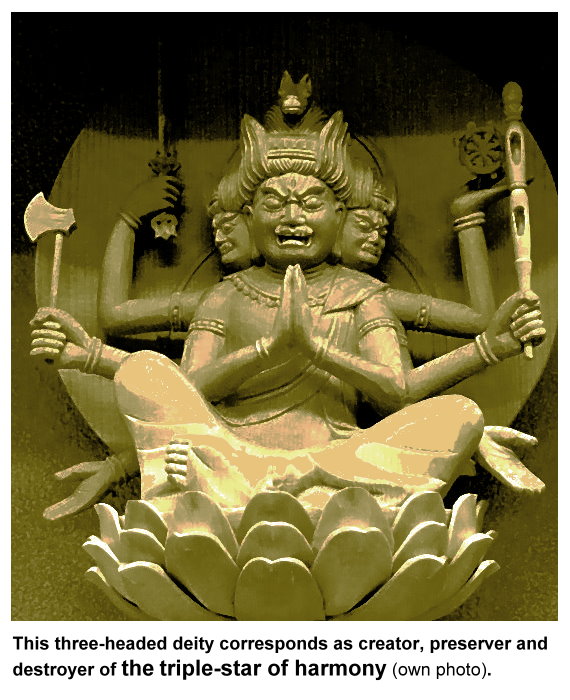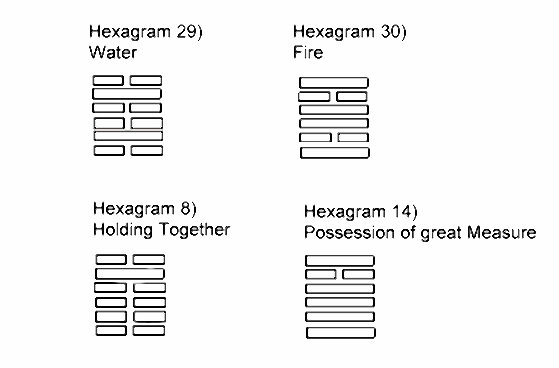The beautiful triple star of harmony – the fingerprint of the structure of the I Ching!

The beautiful triple star of harmony – the fingerprint of the structure of the I Ching!
Previous weblogs show how the 32 Hexagram pairs of the I-Ching are divided in three pair groups, namely in the Hexagram pairs of the pair group Heaven / Earth, in the Hexagram-pairs of the pair group Man / Earth and in the Hexagram pairs of the pair group Heaven / Man. The Hexagrams of the three pair groups differ by their meaning, their distribution of trigrams and their Hexagrams, consisting of two identical trigrams. The latter are the leaders of the three pair groups. The Hexagrams of the pair group Heaven / Earth represent the seasons starts and a new beginning, the Hexagrams of the pair group Man / Earth the equinoxes and solstices and the preservation of creation and the Hexagrams of the pair group Heaven / Man represent the ends of the seasons and the dissolution of creation. The three pair groups meet in Indian mythology, the three deities Brahma, the creator, Vishnu the preserver and Shiva the Destroyer.
Since it is known how the 64 Hexagrams of the I-Ching are distributed to these three pair groups, Hexagram pairs of harmony can be defined, comprising less than 32 Hexagram pairs. In what ways can the beings and things and thus the Hexagrams gain harmony?
The Daodejing (Tao Te Ching in older spelling) (translation by Stephen Mitchell) says:
„All things have their backs to the female
and facing the male.
When male and female combine, all things achieve harmony“.
The following statements, which are attributed to Zhuangzi, is in line with this:
If Yin and Yang combine, he says, in substance, and
Harmony act, the things come into existence.
Elsewhere he says:
„The essence of the Dao is the cessation of opposites,“ and continues:
„The union with the Dao is by correcting the imbalance of Yin and Yang.“
Based on these statements Hexagram pairs of harmony can be defined:
To form a Hexagram pair of harmony, the two Hexagrams must compensate the „imbalance of Yin and Yang“.
Yin and Yang, however, are in a Hexagram pair balanced when each of the six lines of the two Hexagrams is occupied by a Yin and a Yang line. The two Hexagrams that do this, commonly referred to as complementary. (Complementarity is a structural relationship between two trigrams or Hexagrams, in which each line of one is the opposite, i.e., Yin vs. Yang, of the other. For example, Water and Fire, and the Hexagrams 8) Holding Together and 14) Possession of great Measure.

The atomic numbers of the two Hexagrams can follow each other, but they may also be further apart.
If harmony is “ The just adaptation of parts to each other, in any system or combination of things, as is said in a dictionary, then there is between a Hexagram and its complementary Hexagram harmony because on each of the six lines of the two Hexagrams, the two elemental forces Yin and Yang are in balance. But now, each of the 64 Hexagrams has its complementary Hexagram. To find a prominent group of Hexagrams of harmony, there must still be made a selection among the 32 complementary Hexagram-pairs:
Friendships and marriages between members of various ethnic groups are generally more stress exposed as a partnership between members of the same ethnic group. The causes are different manners
and traditions, different languages or different understanding of language. Between members of the same ethnic group these conflicts do not exist
and the conditions for harmony between the partners are better.
In analogy, one can assume that the compliance between a Hexagram and its complementary Hexagram is greater when both are members of the same pair group.
When a Hexagram and its complementary Hexagram belong to the same pair group of Heaven / Earth, Heaven / Man or Man / Earth, I think therefore the harmony between them is greater, as if the two partners are belong to different pair groups.
Such a complementary Hexagram pair therefore I define as a Hexagram pair of harmony.
In the pair group Heaven / Earth, eight Hexagrams have their complementary partner in their own pair group
(Namely, the four complementary Hexagram pairs 1 / 2, 7 / 13; 8 / 14 and 61/62),
in the pair group Heaven / Man there are twelve,
(Namely, the six Hexagram pairs 5 / 35, 6 / 36; 11/12; 17/18; 29/30, and 53/54)
and in the pair group Man / Earth also twelve,
(Namely, the six Hexagram pairs 9 / 16; 15/10; 27/28, 51/57, 52/58 and 63/64).
These 16 complementary Hexagram pairs are according to the above definition, Hexagram pairs of harmony.
The graphical frequency distribution of the trigrams that make up these Hexagrams of harmony, shows in the circle of the Early Heaven the following figure:

I call the figure the triple star of Harmony.
The distribution of the trigrams of the 16 Hexagram pairs of harmony separate for each of the three pair groups shows a beautiful and harmonious figure. In fact, there are three stars, from which
the two stars of the pair groups Heaven / Earth and Heaven / Man
have their maxima at the trigrams Heaven and Earth
(The parents) as well as at the trigrams Water and Fire (the small parents). But the pair group Man / Earth has its maxima at the trigrams Wind and Lake, Thunder and Mountain (the children of the great and little parents). The focus is on the trigrams Heaven and Earth.
Why is the triple-star of harmony the fingerprint of the structure of
the I Ching?
The three pair groups form with their trigrams of its 16
Hexagram pairs of harmony this star. Since all complementary Hexagrams, which have their partners in their own pair group, contained therein, it is specific to the structure of the I Ching.